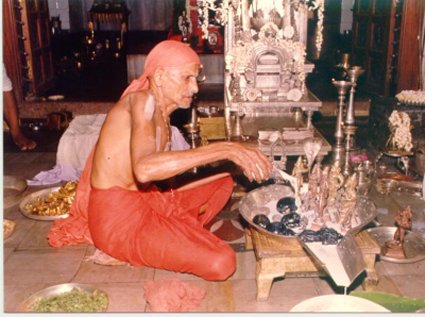

(R. Champakalakshmi. 1981. Orient Longman. pages 193-194.)
Salagrama and Tulasi
Worship of Narayana (Visnu) in the aniconic form called the Salagrama, is an important part of the daily rituals of a Vaisnava household. Salagrama is a flintified ammonite shell and the river Gandaki, one of the tributaries of the Ganges, is famous for its deposits of Salagramas. Each of these has a hole and the spiral grooves visible through the hold are believed to be self-evolved representations of the chakra or discus of Visnu. The number as well as the disposition of the spirals is said to determine the particular aspect or avatara of Visnu symbolised by a Salagrama. The various colours of the Salagramas are associated with different aspects of Visnu, as for example, a brownish black one with Narasimha, a green one with Vamana, a white one with Vasudeva, a red one with Samkarsana and so on.
Salagramas are found also in temples, mathas or monasteries. A garland of Salagramas sometimes adorns the Visnu image in the garbhagriha. But unlike the linga of Shiva, which is the chief cult object enshrined in the in the garbhagriha, the Salagrama occupies only a secondary position in temples. Hence one finds only images of Visnu as the main cult objects enshrined in the garbhagriha. The aniconic worship of Visnu in the form of the Salagrama (also called Visnusila or Krsna sila) seems to be of late origin, whereas the worship of the linga is considerably ancient phenomenon in Saivisim.
Salagrama (Salagrama) is also the name of the Vaisnava tirtha in Andhra Pradesh. Frequent mention to this tirtha is made by the Alvars in their hymns addressed to the holy places of Visnu worship. The earliest reference to this tirtha seems to occur in the Mahabarata. Attempts have also been made to interpret the term pujasila in the Ghosundi inscription (“pujasila prakaro Narayanavatika”) as referring to the aniconic object of worship. But it is more probable, as seen earlier, that the “Narayanavatika” was a compound built for a shrine containing the image of Samkarsana and Vasudeva.
Curious accounts of the origin of Salagrama are found in the Brahmavaivarta Purana and the Varaha Purana. According to one of them, Tulasi (the basil, which is sacred for Visnu worship), was born as the river Gandaki and Narayana promised to be born as her son and hence the deposit of Salagramas on the river banks. In the Varaha Purana account of the origin of the holy place Salagramaksetra, the god is said to have appeared before the sage Salankayana in the form of a sal tree and the village is believed to be named after the sal tree. Such stories ate peurile and of late origin. However, great sanctity is attached to the Salagrama and its worship. Sale or purchase of Salagrama is prohibited.
Women and Sudras are also forbidden from touching it or offering worship to it by themselves. The Salagrama is also included as one of the five symbols connected with the pancayatana puja, believed to have been initated by Sankara, the great philosopher of the eighth century A.D.
The Tulasi or the basil plant is specially sacred to the Hindu and every household has a plant which is worshipped. The garland of Tulasi (Tulay), said to be worn by Visnu, is known to all the early Tamil works. In the daily ritualistic worship of Visnu, Tulasi is offered to the god and later distributed to the worshippers. The significance of the plant may be clearly understood from the descriptions given in the hymns of the Alvars, particularly Nammalvar, who says that Visnu wears it on the shoulders (garland), on the chest, on the head and on the feet, implying the sanctity of the plant. The plant is well known for its medical value and it is used largely in the Arurvedic system of treatment.


